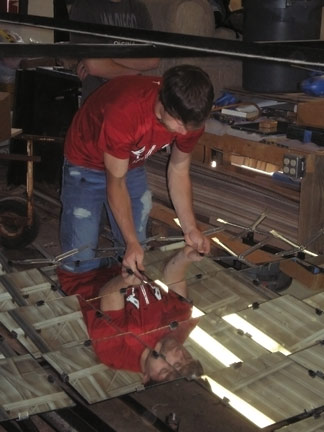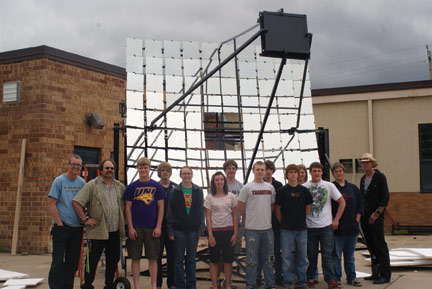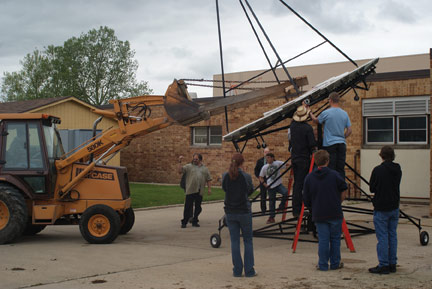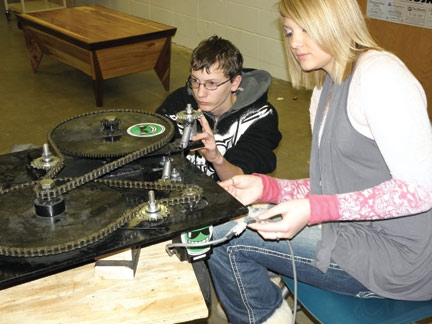The Industrial Technology students at Pleasantville High School, in Pleasantville, Iowa (southeast of Des Moines), have spent the last three years building a multi-mirror solar array. Students from four different technology classes have contributed to the project over the three year period; the AutoCAD and drafting classes have helped design and document the project, students in the metals class performed much of the welding and other fabrication tasks, while students in the electronics class have wired the machine and programmed the PLC. Instructor Frank Vanderpool has been the teacher and mentor who has championed the project from its inception.
The Project
Sunlight is focused on a solar heat exchanger positioned at the focal point of the array. Water is warmed inside the solar heat exchanger and then piped indoors to a storage tank and radiator in the nearby school shop where it is used to heat the room, before circulating back out to the solar heat exchanger to be reheated.
 The array consists of 96 one-foot-square mirrors positioned in a 10×10 array. The four mirrors in the center of the array were omitted – because they would always be occluded from the sun by the solar exchanger. The array/ exchanger assembly is hinged and fitted with wheels so that it can track the sun with both altitude and azimuth motions during each day. Two SureStep stepping systems from AutomationDirect are used to power these two axes of motion via custom gearboxes designed and built by the students.
The array consists of 96 one-foot-square mirrors positioned in a 10×10 array. The four mirrors in the center of the array were omitted – because they would always be occluded from the sun by the solar exchanger. The array/ exchanger assembly is hinged and fitted with wheels so that it can track the sun with both altitude and azimuth motions during each day. Two SureStep stepping systems from AutomationDirect are used to power these two axes of motion via custom gearboxes designed and built by the students.
Three simple photo-resistors are used as sunlight detectors to monitor the position of the sun. These photo-resistors are enclosed in narrow tubes, each with a slit facing skyward. The tubes are aimed ever so slightly away from the angle of the array – so that when sunlight reaches the bottom of the tubes and excites the photo-resistor, this light signals a need to move the array to keep alignment with the sun. One detector is used to monitor the azimuth axis, as the sun only moves in one direction across the sky each day, but two are required for the altitude axis, as the sun rises in the sky during the morning and then falls in the afternoon.
A DirectLOGIC DL06 PLC accepts discrete inputs from the sunlight detectors and uses that information to control the motion of the two stepper systems via H0-CTRIO modules. Additional logic in the PLC is used to approximately position the array on cloudy days so that if/when the clouds dissipate the array is positioned to begin its automatic operation.
 The PLC controls the flow of water through the solar heat exchanger, and also controls a pump inside the storage tank. Analog inputs to the PLC allow the monitoring of temperatures in four locations: at the solar exchanger, at the point where the water enters the building, inside the storage tank, and the temperature of the air inside the shop. Based on the various temperatures, the PLC opens and closes a valve to regulate the flow of water through the loop, and most importantly to stop the flow of water if the array is not producing heat for some reason (perhaps a cloud is blocking the sunlight). The PLC also controls the flow of water across a second heat exchanger inside the storage tank in order to maximize the heat transfer into the storage tank when possible.
The PLC controls the flow of water through the solar heat exchanger, and also controls a pump inside the storage tank. Analog inputs to the PLC allow the monitoring of temperatures in four locations: at the solar exchanger, at the point where the water enters the building, inside the storage tank, and the temperature of the air inside the shop. Based on the various temperatures, the PLC opens and closes a valve to regulate the flow of water through the loop, and most importantly to stop the flow of water if the array is not producing heat for some reason (perhaps a cloud is blocking the sunlight). The PLC also controls the flow of water across a second heat exchanger inside the storage tank in order to maximize the heat transfer into the storage tank when possible.
 On a sunny day the results can be more than impressive. In fact, on several occasions, the water has boiled and pressurized steam (measured at over 104°C) has caused problems such as blown hoses, requiring the team to reevaluate their design and method of operation. Other issues involved the inadvertent focusing of sunlight on a wooden component which actually caught on fire. Today, they have those issues resolved and water temperatures in the storage tank average about 165-180°F even on moderately sunny days. They routinely heat the shop exclusively with solar energy throughout the day and even for a few extra hours after the sun goes down due to the thermal energy stored in the tank.
On a sunny day the results can be more than impressive. In fact, on several occasions, the water has boiled and pressurized steam (measured at over 104°C) has caused problems such as blown hoses, requiring the team to reevaluate their design and method of operation. Other issues involved the inadvertent focusing of sunlight on a wooden component which actually caught on fire. Today, they have those issues resolved and water temperatures in the storage tank average about 165-180°F even on moderately sunny days. They routinely heat the shop exclusively with solar energy throughout the day and even for a few extra hours after the sun goes down due to the thermal energy stored in the tank.
Looking Forward
Future plans include switching the plumbing over to steam fittings to take advantage of the higher temperatures and pressures which have already been proven possible.  Once they make that leap, they even envision the potential to run a small steam engine and produce electricity from the system. Frank Vanderpool is understandably proud of what his students have achieved this far. He reports, “The project has been, and continues to be, a wonderful learning experience for all of the students involved. The Multi-Mirror Solar Array has become a symbol of cooperative learning at Pleasantville High.”
Once they make that leap, they even envision the potential to run a small steam engine and produce electricity from the system. Frank Vanderpool is understandably proud of what his students have achieved this far. He reports, “The project has been, and continues to be, a wonderful learning experience for all of the students involved. The Multi-Mirror Solar Array has become a symbol of cooperative learning at Pleasantville High.”
Provided by Chip McDaniel
AutomationDirect
Originally Posted: June 1, 2011

